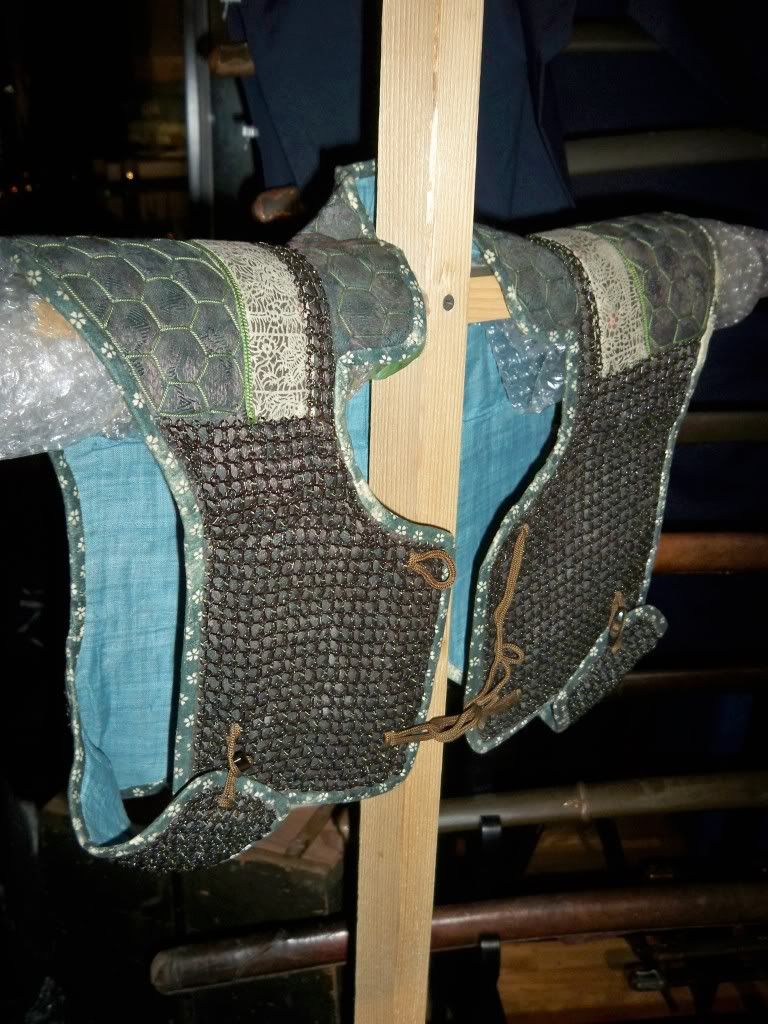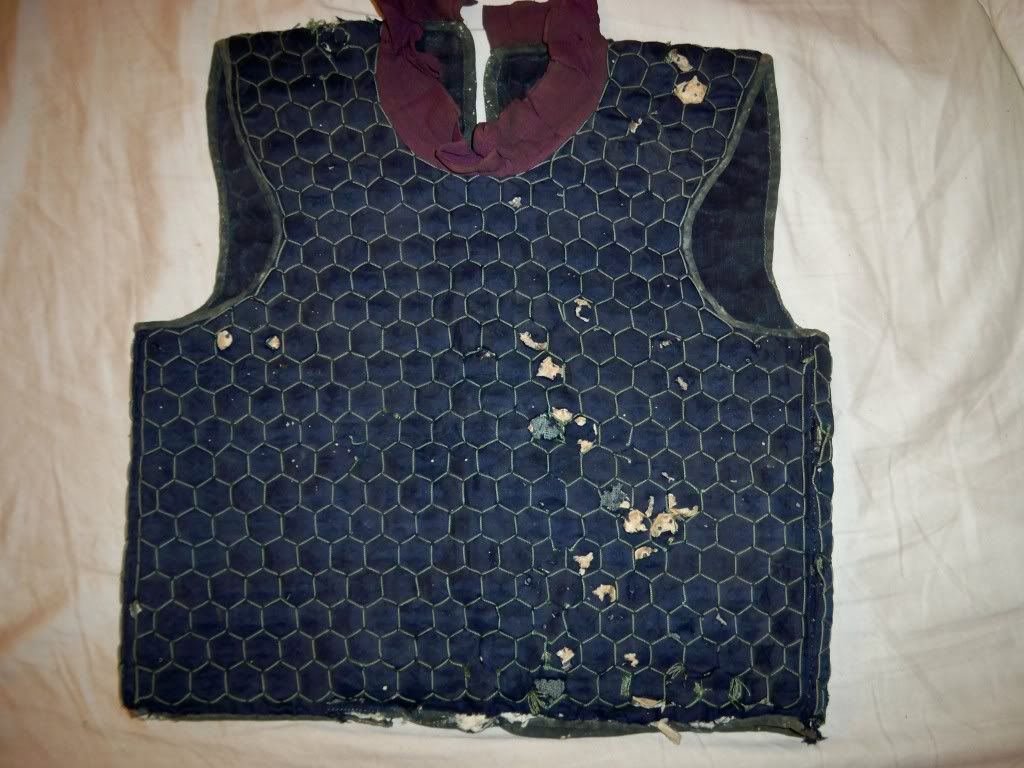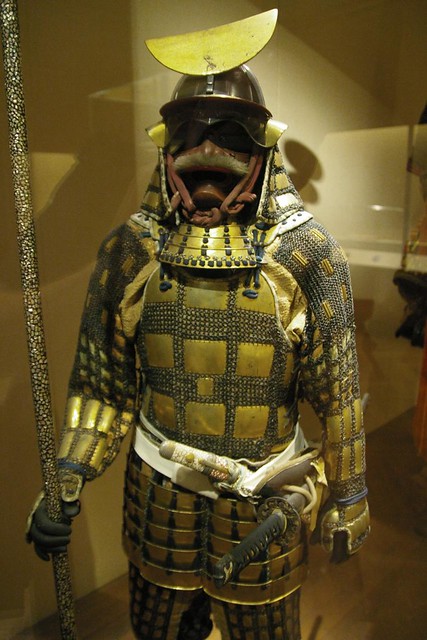AUXILIARY JAPANESE ARMOURS OF JAPAN
Auxiliary Japanese armours are optional armour items worn by
the samurai class of feudal Japan in addition to the traditional six armour
components.
Description
The six major articles or components of Japanese armour (hei-no-rokugu,
rokugu, or rokugusoku) are the dou or dō (chest armour), kabuto (helmet), mengu
(facial armour), kote (armoured sleeves), sune-ate (shin armour), and the
hai-date (thigh armour). Additional armour protection was available for the
neck, armpit, chest, waist and feet. These auxiliary armours covered areas of
the body that were exposed by gaps in the regular armour items or were
additional protection was required.
Wakibiki
Wakibiki are simple rectangles of cloth covered with kusari
(chain armor), karuta (small rectangular or square plates), or kikko (hexagon
plates), these iron or leather armors or a combination of them were sewn to the
cloth backing. Wakibiki could also be made from one solid piece of iron or
hardened leather.[4] The wakibiki had cords connected to them which allowed the
wakibiki to hang from the shoulder, the wakibiki was then suspended over the
exposed arm pit area. Wakibiki were worn inside the of the chest armourdou (dō)
or on the outside depending on the type.
A pair of antique Japanese (samurai) tetsu (iron) wakibiki
(armpit protectors)
A tetsu (iron) wakibiki installed on a honiyozanedou.
A pair of antique Japanese (samurai) Edo period
kikkowakibiki.
Manju no wa
Manju no wa, ( alsomanjunowa or manjunowa ) are a
combination of shoulder pads, collar and armpit guards in one that protected
the upper chest area. Manju no wa were covered with different types of armour
including kusari (chain armour), karuta (small square or rectangular armor
plates), or kikko (hexagon plates), these iron or leather armors or a
combination of them were sewn to a cloth backing. The armour could be exposed
or hidden between a layer of cloth. When worn the manju no wa looked like a
small tight fitting vest. Manju no wa have small wings that would pass under
the arm pit area from the back and attach to the front of the manju no wa with
a button, toggle or ties.
An
antique Japanese (samurai) manju no wa. This manju no wa is made with a lining
of kusari (chain armor) hidden between an inner and outer layer of cloth.
Antique Japanese (samurai) manju no wa. Kusari (chain
armour) and kikko (small hexagon armor plates) sewn to cloth.
Antique Japanese (samurai) manju-no-wa, made from chain
armor kusari sewn to a cloth backing.
Manchira
Manchira are a type of armoured vest covered with different
types of armour including kusari (chain armour), karuta (small square or
rectangular armor plates), or kikko (hexagon plates), these iron or leather
armors or a combination of them were sewn to a cloth backing. The armour could
be exposed or hidden between a layer of cloth. Manchira are usually larger than
manju no wa and protected the chest area and sometimes the neck and arm pit. Some
manchira could be worn over the chest armor dou (dō) .
Japanese (samurai) Edo period Japanese (samurai) kikko vest
manchira.
Tate-eri
Tate-eri are small padded pillow like pieces with a standing
armoured collar that sits on the shoulder to protect from the weight of the
chest armor (dou or dō) The standing collar would be lined with kikko (hexagon
plates) armor to protect the neck.
Tare-eri, installed on a dou (dō) (chest armour).
Kogake
Kogake are various types of armouredtabi foot coverings that
could cover just the top of the foot or be worn as a shoe or slipper. Kogake
could be covered with small iron plates or kusari (chain armour).
Nodowa and guruwa
Nodowa and guruwa are similar types of neck protection, the
nodowa would be tied around the back of the neck and the guruwa wrapped
completely around the neck.
Model for this clothes :
PAST • FUTURE
ENTRY
FOOD
RESEPI OKONOMIYAKI
RESEPI DORAYAKI
RESEPI TAKOYAKI
RESEPI MAKIZUSHI
RESEPI SALMON ONIGIRI
RESEPI YAKI ONIGIRI
RESEPI KOROKKE
RESIPI KARI NASI
RESEPI KINAKO
RESEPI MENTAIKO
RESEPI TOFU SALAD
COMING SOON !
COMING SOON !
COMING SOON !
ORIGAMI
ORIGAMI BIRD
ORIGAMI PANDA
ORIGAMI OWL
ORIGAMI CAT
ORIGAMI RABBIT
ORIGAMI FOX
ORIGAMI BEAR
ORIGAMI
ORIGAMI RABBIT
ORIGAMI FISH
ORIGAMI T SHIRT
ORIGAMI KAPPA
FESTIVAL
CHILDREN'S DAY
BON ODORI
HANAMI
HINAMATSURI
COMING SOON !
COMING SOON !
COMING SOON !
MUSIC
CASSIS
THE GAZZETE
SNSD - GEE
MIWA - PROFILE
MIWA ホイッスル~君と過ごした日々
MIWA - HIKARIE
AI NO UTA LYRICS
DIAURA - LOST NOVEMBER
COMING SOON !
ANIME
TONARI NO TOTORO
SEN TO CHIHIRO NO KAMIKAKUSHI (SPIRITED AWAY)
MOVING CASTLE
NARUTO
CUTICLE DETECTIVE INABA
ANOHANA : THE FLOWER WE SAW THAT DAY
TAMAKO MARKET
K-ON !
NYAN KOI
NISHIJOU
HARUHI SUZUMIYA
KIMI TO BOKU
TARI TARI
KOKORO CONNECT
YURU YURI
AMNESIA
BEELZEBUB
UNBREAKABLE MACHINE DOLL
COMING SOON !
COMING SOON !
CLOTHES
AUXILIARY JAPANESE ARMOURS OF JAPAN
FURISODE
HAKAMA
HANTEN
HAPPI
HARAMAKI
HOMONGI
JOE
JINBEI
JUNIHITOE
KAPPOGI
KOSODE
GAMES
HANETSUKI
HANA ICHI MONME
SOGOROKU
SHONGI
ORIGAMI
OHAJIKI
AYATORI
TAKE-UMA
KENDAMA
DARUMA-SAN GA KORONDA
MENKO
OTEDAMA
BEIGOMA
TOURISM
AKAME SHIJUHACHITAKI WATERFALLS
OSAKA
HIROSHIMA
ASAKUSA KANNON TEMPLE
STUDY TOUR
UNIVERSITY OF TOKYO
COMING SOON !
COMING SOON !
COMING SOON !
COMING SOON !
COMING SOON !
LANGUAGE
LETS LEARN JAPANESE
JAPANESE GREETINGS AND WRITING SYSTEM
COMING SOON !
COMING SOON !
MOVIES AND DRAMA
KIMI NI TODOKE
ICHI LITRE NO NAMIDA ( 1 LITRE OF TEARS)
HANA KIMI
HONEY AND CLOVER
BOYS OVER FLOWER
COMING SOON !
LIVING ABROAD
TATAMI ROOM
100 YEN SHOP
TAXI
TOKYO SUBWAY
ECONOMIC DAILY LIFE
CONSUMER HABIT
EATING HABIT
SCHOOL LIFE
AUXILIARY JAPANESE ARMOURS OF JAPAN
Auxiliary Japanese armours are optional armour items worn by
the samurai class of feudal Japan in addition to the traditional six armour
components.
Description
The six major articles or components of Japanese armour (hei-no-rokugu,
rokugu, or rokugusoku) are the dou or dō (chest armour), kabuto (helmet), mengu
(facial armour), kote (armoured sleeves), sune-ate (shin armour), and the
hai-date (thigh armour). Additional armour protection was available for the
neck, armpit, chest, waist and feet. These auxiliary armours covered areas of
the body that were exposed by gaps in the regular armour items or were
additional protection was required.
Wakibiki
Wakibiki are simple rectangles of cloth covered with kusari
(chain armor), karuta (small rectangular or square plates), or kikko (hexagon
plates), these iron or leather armors or a combination of them were sewn to the
cloth backing. Wakibiki could also be made from one solid piece of iron or
hardened leather.[4] The wakibiki had cords connected to them which allowed the
wakibiki to hang from the shoulder, the wakibiki was then suspended over the
exposed arm pit area. Wakibiki were worn inside the of the chest armourdou (dō)
or on the outside depending on the type.
A pair of antique Japanese (samurai) tetsu (iron) wakibiki
(armpit protectors)
A tetsu (iron) wakibiki installed on a honiyozanedou.
A pair of antique Japanese (samurai) Edo period
kikkowakibiki.
Manju no wa
Manju no wa, ( alsomanjunowa or manjunowa ) are a
combination of shoulder pads, collar and armpit guards in one that protected
the upper chest area. Manju no wa were covered with different types of armour
including kusari (chain armour), karuta (small square or rectangular armor
plates), or kikko (hexagon plates), these iron or leather armors or a
combination of them were sewn to a cloth backing. The armour could be exposed
or hidden between a layer of cloth. When worn the manju no wa looked like a
small tight fitting vest. Manju no wa have small wings that would pass under
the arm pit area from the back and attach to the front of the manju no wa with
a button, toggle or ties.
An
antique Japanese (samurai) manju no wa. This manju no wa is made with a lining
of kusari (chain armor) hidden between an inner and outer layer of cloth.
Antique Japanese (samurai) manju no wa. Kusari (chain
armour) and kikko (small hexagon armor plates) sewn to cloth.
Antique Japanese (samurai) manju-no-wa, made from chain
armor kusari sewn to a cloth backing.
Manchira
Manchira are a type of armoured vest covered with different
types of armour including kusari (chain armour), karuta (small square or
rectangular armor plates), or kikko (hexagon plates), these iron or leather
armors or a combination of them were sewn to a cloth backing. The armour could
be exposed or hidden between a layer of cloth. Manchira are usually larger than
manju no wa and protected the chest area and sometimes the neck and arm pit. Some
manchira could be worn over the chest armor dou (dō) .
Japanese (samurai) Edo period Japanese (samurai) kikko vest
manchira.
Tate-eri
Tate-eri are small padded pillow like pieces with a standing
armoured collar that sits on the shoulder to protect from the weight of the
chest armor (dou or dō) The standing collar would be lined with kikko (hexagon
plates) armor to protect the neck.
Tare-eri, installed on a dou (dō) (chest armour).
Kogake
Kogake are various types of armouredtabi foot coverings that
could cover just the top of the foot or be worn as a shoe or slipper. Kogake
could be covered with small iron plates or kusari (chain armour).
Nodowa and guruwa
Nodowa and guruwa are similar types of neck protection, the
nodowa would be tied around the back of the neck and the guruwa wrapped
completely around the neck.
Model for this clothes :
PAST • FUTURE
|
lovelies
 We are from SMK Ibrahim. Please leave your footstep on our message board. Follow us and we will follow you back
We are from SMK Ibrahim. Please leave your footstep on our message board. Follow us and we will follow you back
MESSAGE BOARD

BLOG ARCHIVE;
SHOGI
SOGOROKU
HANA ICHI MONME
HANETSUKI
CHILDREN'S DAY
ORIGAMI BIRD
KAICHOU WA MAID-SAMA
FAIRY TAIL
NODAME CANTABILE LIVE ACTION
ICHI LITRE NO NAMIDA ( 1 LITRE OF TEARS)
|

























































































